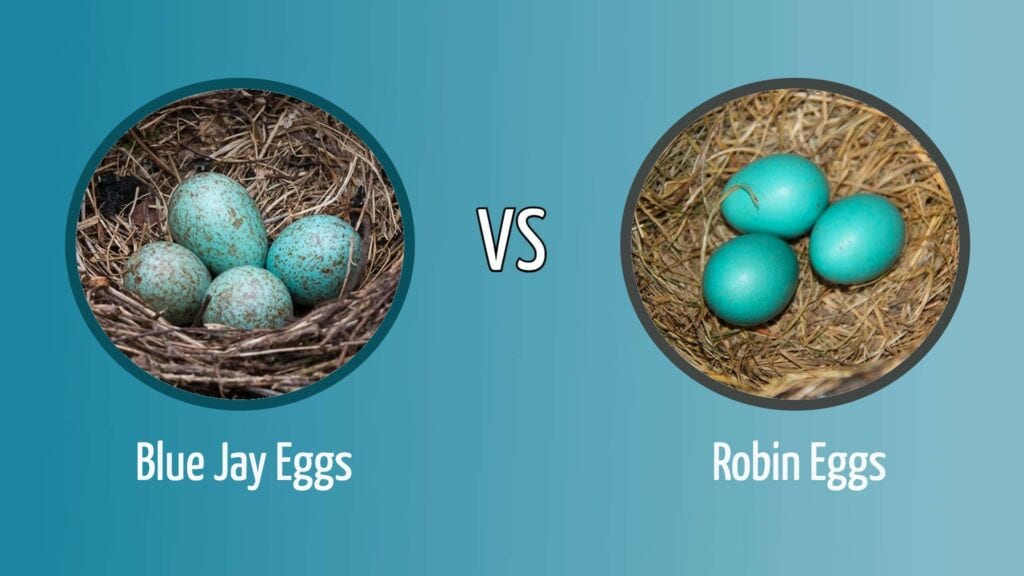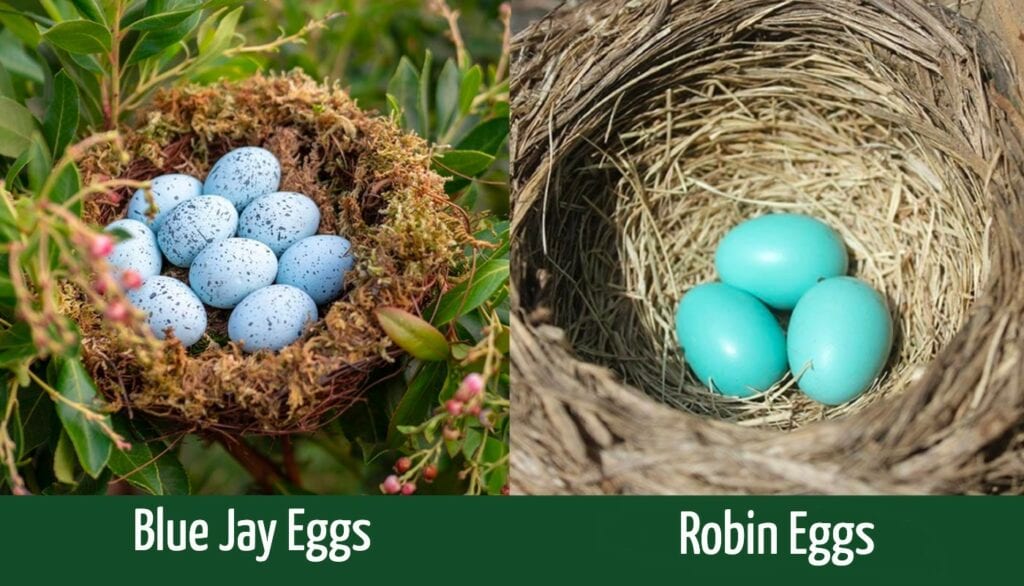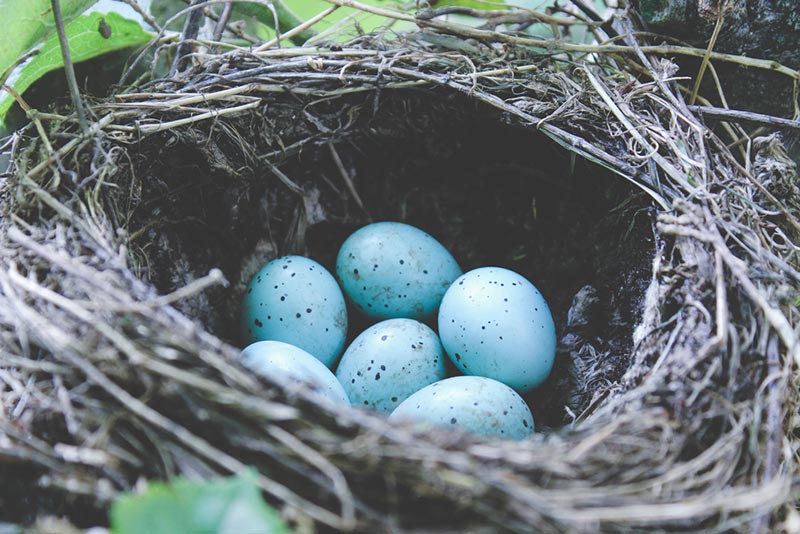Blue Jay Eggs vs. Robin Eggs: How to Tell the Difference
Last Updated on

Blue jays and robins are two of the most popular and common birds in the U.S. They’re both attractive birds. Although there are obvious differences between the adults, their eggs are sometimes mistaken because they can be a similar color, are the same size, and have a similar number in a clutch of eggs.
However, while both birds tend to lay blue eggs, blue jay eggs are also usually speckled or spotted. While it is possible for robin eggs to also have a speckling, this is rare, and when it does exist, the speckling is lighter. Read on for more information about these two egg types and how to identify them.

Visual Differences

At a Glance
- Clutch Size: 2–7
- Egg Size: 1–1.3 inches
- Egg Color: Blue with brown speckling
- Clutch Size: 3–5
- Egg Size: 1.1–1.2 inches
- Egg Color: Blue

Blue Jay Eggs Overview
The blue jay is a large songbird with a striking blue appearance and a tuft on the back of its head that make the species an easy bird to spot and a good choice for keen watchers. It is an intelligent bird species and one that is especially fond of acorns. They are found throughout the Southeast of the country and usually nest between 10–25 feet off the ground with the male and female responsible for gathering nesting materials.

Blue Jay Nesting
Blue jays typically nest between March and July with peak season occurring at the end of April in most regions. Once nest building begins, it will usually be several more weeks before the eggs are laid. Although the species usually only has one brood per season, they can rarely have two broods in a single year.
A single brood can consist of between two and seven eggs, with most broods containing four or five. Both parents provide food for their young, and while some pairs do use the same nest 2 years in a row, it is more common for them to find a new nesting site every season.
Blue Jay Eggs
The eggs of the blue jay are oval, and although some can be a buff or brown color, they are usually a bluish-green color. The eggs have speckles towards the rounded end, and the speckles can be brown in color but might sometimes be a gray color.

Robin Eggs Overview
American robins are also songbirds but appear quite different from blue jays. They have a dark brown back, wings, and head, with a distinctive orange breast. They do live in urban areas but may also be found in wilder regions. They are found throughout the U.S. They are omnivores, especially enjoying worms from the garden, but they primarily eat fruit and berries during fall and winter and may become intoxicated when they exclusively feast on honeysuckle berries. Robins sing a lot, and identifying and following their song is one of the best ways of locating this appealing little bird.

Robin Nesting
Robins are treated as a sign of impending spring. However, many populations of robins will remain throughout the year, although they are less visible and are more likely to stay hidden. They can nest anywhere from woodlands to nesting boxes in urban gardens. The species is one of the earliest to nest in the U.S., with a first brood potentially laid in April. Most broods consist of three or four eggs, but the species can have five eggs, and the early nesting of the robin means that this little songbird can have as many as three broods in a season.
Robin Eggs
The robin’s egg has a distinct appearance. They are a bright blue color—a color that has come to be described as robin egg blue. The eggs are smooth and do not usually have speckles, spots, or other marks. They are about the size of a quarter.
What Are the Differences Between Blue Jay Eggs and Robin Eggs?
There are some similarities between robin and blue jay eggs in that they might appear a similar color and are of a similar size and shape. However, the blue jay egg tends to be greener than the bright blue of the robin egg, and while the blue jay egg is speckled or spotted, a robin egg is typically a uniform color with no speckles or other markings.
Regardless of whether you believe you have found blue jay or robin eggs, you should not disturb the eggs or the nest. If you believe they have been abandoned, contact a local wildlife sanctuary or group and they will come and visit the site or provide advice on what to do. Similarly, if you find an egg on the floor that is in good condition, you should contact a local wildlife rescue since they may be able to incubate the egg, as some can hatch without their parents.

Conclusion
Robins and blue jays are two of the most popular songbirds in the U.S. because of their attractive appearance and their songs. While the two birds have very different physical characteristics, their eggs are more similar to one another in appearance. However, robin eggs tend to be bright blue in color with no other markings, whereas the blue jay egg has a greener blue color and speckles around the rounded end of the egg.
Featured Image Credit: Blue Jay Eggs (Juris-Kraulis, Shutterstock) Robin Eggs (lmt56, Pixabay)
About the Author Robert Sparks
Robert’s obsession with all things optical started early in life, when his optician father would bring home prototypes for Robert to play with. Nowadays, Robert is dedicated to helping others find the right optics for their needs. His hobbies include astronomy, astrophysics, and model building. Originally from Newark, NJ, he resides in Santa Fe, New Mexico, where the nighttime skies are filled with glittering stars.
Related Articles:
10 Types of Hummingbirds in Arkansas (With Pictures)
8 Types of Hummingbirds in Nebraska (With Pictures)
5 Types of Hummingbirds in Idaho (With Pictures)
3 Types of Hummingbirds in Mississippi (With Pictures)
8 Types of Hummingbirds in Kansas (With Pictures)
5 Types of Hummingbirds in West Virginia (With Pictures)
5 Types of Hummingbirds in Ohio (With Pictures)
Where Do Nuthatches Nest? Nuthatch Nesting Habits Explained
